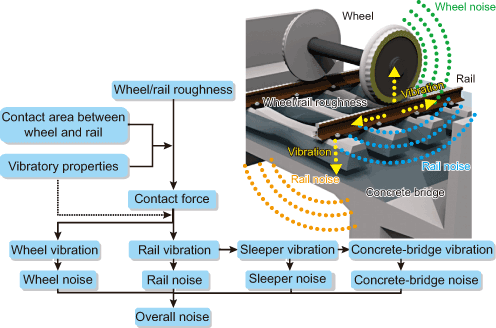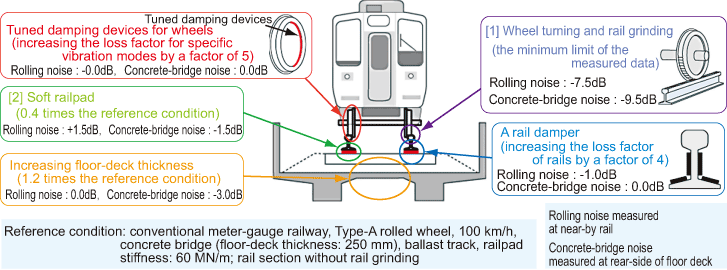2. Prediction model for rolling noise/concrete-bridge noise and evaluation of the effects of countermeasures
- The RTRI developed a prediction model for rolling noise and concrete-bridge noise.
- The effects of countermeasures for rolling noise/concrete-bridge noise are estimated.
Rolling noise and concrete-bridge noise are the main noise sources for conventional metre-gauged railway lines in Japan. Rolling noise and concrete-bridge noise are generated by their vibrations due to the excitation force at the contact area between wheel and rail. The RTRI has gained insight into rolling noise/concrete-bridge noise generation through field tests and numerical simulations, and developed a prediction model based on vibratory and acoustic characteristics of both noise sources. This research helped to develop noise abatement countermeasures targeting both sources (Fig. 1).
Figure 2 shows the effects of countermeasures using the prediction model. The parameters used in the model are obtained from field tests, e.g. loss factor of wheel and rail, etc. It is found that rolling noise and concrete-bridge noise are considerably reduced by controlling wheel/rail roughness [(1)], and that the tuning of railpad stiffness is also effective for noise reduction [(2)]. The results are partly validated in terms of noise and vibration.
The effects of countermeasures for rolling noise and concrete-bridge noise can be estimated by using the prediction model, allowing for the contribution of rolling noise and concrete-bridge noise to the total.
 Fig. 1 Prediction model for estimating rolling noise and concrete-bridge noise
Fig. 1 Prediction model for estimating rolling noise and concrete-bridge noise Fig. 2 Estimation of the noise reduction using the prediction model for rolling noise and concrete-bridge noise
Fig. 2 Estimation of the noise reduction using the prediction model for rolling noise and concrete-bridge noise